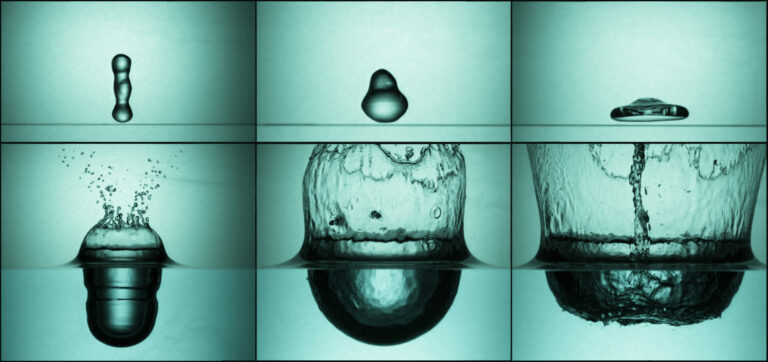Mechanical Engineering
When icy surfaces aren’t a drag
High-speed imaging of perfect ice spheres free-falling in water reveals surprising insights into drag reduction.


Researchers have discovered that thin layers of water on the surface of ice-coated metal spheres can significantly reduce the effects of drag resistance. Watch the video.
Reproduced with permission from Ref 1© 2015 American Physical Society
The mystery of how thin films of water contribute to the slickness of icy surfaces has intrigued curious minds since the 19th century. Now an international team led by researchers from KAUST found that melting ice on surfaces can reduce hydrodynamic drag by up to 50 percent1 — a revelation that may benefit fields from climate modelling to microscale chemical reactions.
When a sphere such as a golf ball travels through the atmosphere, hydrodynamic drag plays a decisive role in deciding its final trajectory. This force opposes objects as they move through a medium and normally increases with increasing speed.
Under certain conditions, however, the drag starts to diminish as the object gains speed. This paradox, which is known as the “drag crisis,” arises when a thin boundary layer in the air enveloping the sphere becomes turbulent itself and narrows the trailing wake behind it — a phenomenon exploited by golf ball dimples to improve driving distance.
Surprisingly, the hydrodynamic drag acting on ice-covered bodies immersed in water has never been quantified. KAUST’s Ivan Vakarelski and Siggi Thoroddsen aimed to resolve this situation by studying how ice spheres containing metal cores for weight would undergo free-fall in water tanks.
Despite the simplicity of this concept, it took the team more than a year to overcome the technical challenges to produce ice spheres with surfaces smooth enough for highly accurate measurements.
Before releasing an ice sphere from its custom-designed mold, the researchers let it melt at room temperature for a short time until water layers appeared on the surface. They then released the spheres into tanks and recorded their descent with a high-speed video camera. The images showed that the slippery coatings cut the hydrodynamic drag in half compared to drag on pure metal spheres.
To understand the drag reduction, the KAUST team looked at the ice melting rates as determined by changes in sphere diameters with time. These analyses revealed that the melting ice constantly transferred mass to the boundary layers around the spheres, triggering turbulence and a quick transition to drag crisis conditions.
Vakarelski noted that the results gleaned from the study can help calculations of iceberg movements in warming climates, and might also have a broader influence.
“We think the ice–water system is an example of how surface reactions on a micro scale, such as melting, can couple with macroscopic phenomenon such as hydrodynamic drag. These unexplored areas can significantly impact transport processes,” Vakarelski said.
References
- Vakarelski, I.U., Chan, D.Y.C. & Thoroddsen, S.T. Drag modulation by the melting of an ice surface in contact with water. Physical Review Letters 115, 044501 (2015). | article
You might also like

Mechanical Engineering
Innovative strain sensor design enables extreme sensitivity

Mechanical Engineering
Turbulent flow shows surprise patterns that could help boost efficiency

Mechanical Engineering
Machine learning model identifies gas molecules

Mechanical Engineering
Making a splash: unraveling the impact of large water droplets

Mechanical Engineering
Sour gas has sweet potential for hydrogen production

Mechanical Engineering
Dancing droplets’ new spin on water harvesting

Mechanical Engineering
Underwater air pockets smooth out the bumps

Chemistry



